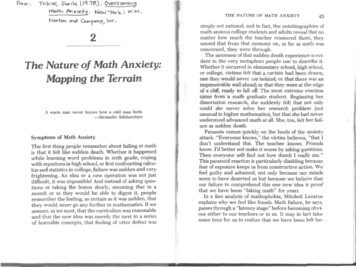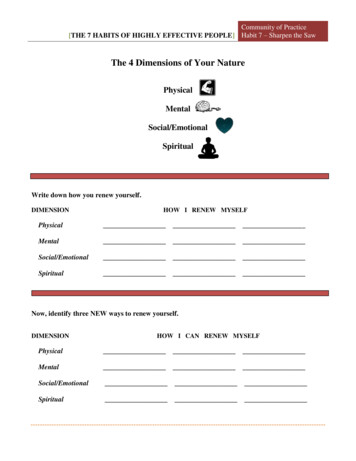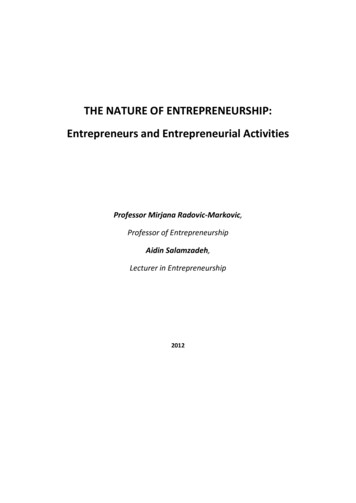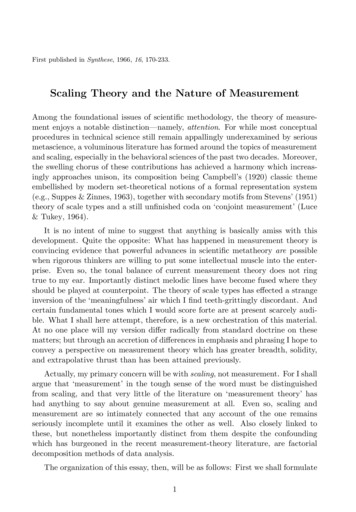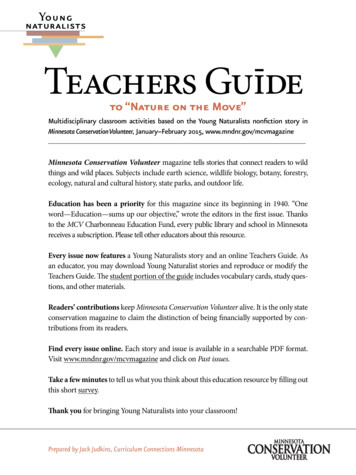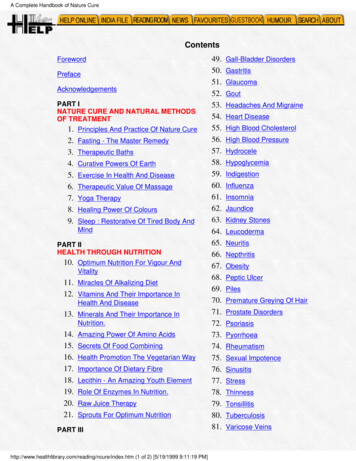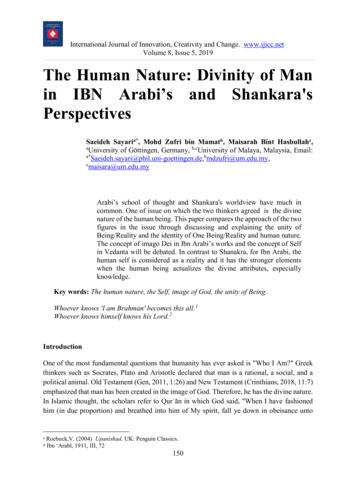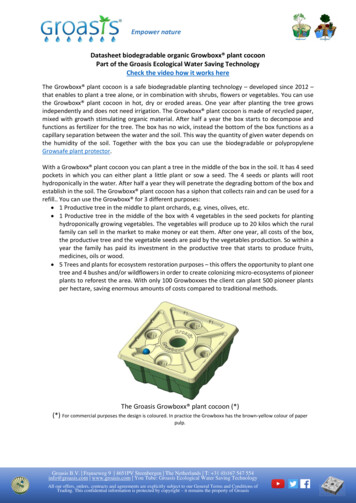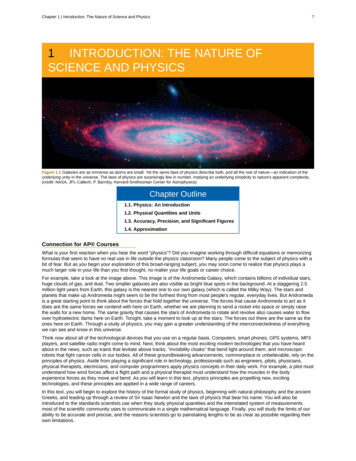
Transcription
Chapter 1 Introduction: The Nature of Science and Physics71 INTRODUCTION: THE NATURE OFSCIENCE AND PHYSICSFigure 1.1 Galaxies are as immense as atoms are small. Yet the same laws of physics describe both, and all the rest of nature—an indication of theunderlying unity in the universe. The laws of physics are surprisingly few in number, implying an underlying simplicity to nature's apparent complexity.(credit: NASA, JPL-Caltech, P. Barmby, Harvard-Smithsonian Center for Astrophysics)Chapter Outline1.1. Physics: An Introduction1.2. Physical Quantities and Units1.3. Accuracy, Precision, and Significant Figures1.4. ApproximationConnection for AP CoursesWhat is your first reaction when you hear the word “physics”? Did you imagine working through difficult equations or memorizingformulas that seem to have no real use in life outside the physics classroom? Many people come to the subject of physics with abit of fear. But as you begin your exploration of this broad-ranging subject, you may soon come to realize that physics plays amuch larger role in your life than you first thought, no matter your life goals or career choice.For example, take a look at the image above. This image is of the Andromeda Galaxy, which contains billions of individual stars,huge clouds of gas, and dust. Two smaller galaxies are also visible as bright blue spots in the background. At a staggering 2.5million light years from Earth, this galaxy is the nearest one to our own galaxy (which is called the Milky Way). The stars andplanets that make up Andromeda might seem to be the furthest thing from most people's regular, everyday lives. But Andromedais a great starting point to think about the forces that hold together the universe. The forces that cause Andromeda to act as itdoes are the same forces we contend with here on Earth, whether we are planning to send a rocket into space or simply raisethe walls for a new home. The same gravity that causes the stars of Andromeda to rotate and revolve also causes water to flowover hydroelectric dams here on Earth. Tonight, take a moment to look up at the stars. The forces out there are the same as theones here on Earth. Through a study of physics, you may gain a greater understanding of the interconnectedness of everythingwe can see and know in this universe.Think now about all of the technological devices that you use on a regular basis. Computers, smart phones, GPS systems, MP3players, and satellite radio might come to mind. Next, think about the most exciting modern technologies that you have heardabout in the news, such as trains that levitate above tracks, “invisibility cloaks” that bend light around them, and microscopicrobots that fight cancer cells in our bodies. All of these groundbreaking advancements, commonplace or unbelievable, rely on theprinciples of physics. Aside from playing a significant role in technology, professionals such as engineers, pilots, physicians,physical therapists, electricians, and computer programmers apply physics concepts in their daily work. For example, a pilot mustunderstand how wind forces affect a flight path and a physical therapist must understand how the muscles in the bodyexperience forces as they move and bend. As you will learn in this text, physics principles are propelling new, excitingtechnologies, and these principles are applied in a wide range of careers.In this text, you will begin to explore the history of the formal study of physics, beginning with natural philosophy and the ancientGreeks, and leading up through a review of Sir Isaac Newton and the laws of physics that bear his name. You will also beintroduced to the standards scientists use when they study physical quantities and the interrelated system of measurementsmost of the scientific community uses to communicate in a single mathematical language. Finally, you will study the limits of ourability to be accurate and precise, and the reasons scientists go to painstaking lengths to be as clear as possible regarding theirown limitations.
8Chapter 1 Introduction: The Nature of Science and PhysicsChapter 1 introduces many fundamental skills and understandings needed for success with the AP Learning Objectives. Whilethis chapter does not directly address any Big Ideas, its content will allow for a more meaningful understanding when these BigIdeas are addressed in future chapters. For instance, the discussion of models, theories, and laws will assist you inunderstanding the concept of fields as addressed in Big Idea 2, and the section titled ‘The Evolution of Natural Philosophy intoModern Physics' will help prepare you for the statistical topics addressed in Big Idea 7.This chapter will also prepare you to understand the Science Practices. In explicitly addressing the role of models in representingand communicating scientific phenomena, Section 1.1 supports Science Practice 1. Additionally, anecdotes about historicalinvestigations and the inset on the scientific method will help you to engage in the scientific questioning referenced in SciencePractice 3. The appropriate use of mathematics, as called for in Science Practice 2, is a major focus throughout sections 1.2, 1.3,and 1.4.1.1 Physics: An IntroductionFigure 1.2 The flight formations of migratory birds such as Canada geese are governed by the laws of physics. (credit: David Merrett)Learning ObjectivesBy the end of this section, you will be able to: Explain the difference between a principle and a law. Explain the difference between a model and a theory.The physical universe is enormously complex in its detail. Every day, each of us observes a great variety of objects andphenomena. Over the centuries, the curiosity of the human race has led us collectively to explore and catalog a tremendouswealth of information. From the flight of birds to the colors of flowers, from lightning to gravity, from quarks to clusters of galaxies,from the flow of time to the mystery of the creation of the universe, we have asked questions and assembled huge arrays offacts. In the face of all these details, we have discovered that a surprisingly small and unified set of physical laws can explainwhat we observe. As humans, we make generalizations and seek order. We have found that nature is remarkably cooperative—itexhibits the underlying order and simplicity we so value.It is the underlying order of nature that makes science in general, and physics in particular, so enjoyable to study. For example,what do a bag of chips and a car battery have in common? Both contain energy that can be converted to other forms. The law ofconservation of energy (which says that energy can change form but is never lost) ties together such topics as food calories,batteries, heat, light, and watch springs. Understanding this law makes it easier to learn about the various forms energy takesand how they relate to one another. Apparently unrelated topics are connected through broadly applicable physical laws,permitting an understanding beyond just the memorization of lists of facts.The unifying aspect of physical laws and the basic simplicity of nature form the underlying themes of this text. In learning to applythese laws, you will, of course, study the most important topics in physics. More importantly, you will gain analytical abilities thatwill enable you to apply these laws far beyond the scope of what can be included in a single book. These analytical skills will helpyou to excel academically, and they will also help you to think critically in any professional career you choose to pursue. Thismodule discusses the realm of physics (to define what physics is), some applications of physics (to illustrate its relevance toother disciplines), and more precisely what constitutes a physical law (to illuminate the importance of experimentation to theory).Science and the Realm of PhysicsScience consists of the theories and laws that are the general truths of nature as well as the body of knowledge they encompass.Scientists are continually trying to expand this body of knowledge and to perfect the expression of the laws that describe it.Physics is concerned with describing the interactions of energy, matter, space, and time, and it is especially interested in whatfundamental mechanisms underlie every phenomenon. The concern for describing the basic phenomena in nature essentiallydefines the realm of physics.Physics aims to describe the function of everything around us, from the movement of tiny charged particles to the motion ofpeople, cars, and spaceships. In fact, almost everything around you can be described quite accurately by the laws of physics.Consider a smart phone (Figure 1.3). Physics describes how electricity interacts with the various circuits inside the device. ThisThis content is available for free at http://cnx.org/content/col11844/1.13
Chapter 1 Introduction: The Nature of Science and Physics9knowledge helps engineers select the appropriate materials and circuit layout when building the smart phone. Next, consider aGPS system. Physics describes the relationship between the speed of an object, the distance over which it travels, and the timeit takes to travel that distance. When you use a GPS device in a vehicle, it utilizes these physics equations to determine thetravel time from one location to another.Figure 1.3 The Apple “iPhone” is a common smart phone with a GPS function. Physics describes the way that electricity flows through the circuits ofthis device. Engineers use their knowledge of physics to construct an iPhone with features that consumers will enjoy. One specific feature of an iPhoneis the GPS function. GPS uses physics equations to determine the driving time between two locations on a map. (credit: @gletham GIS, Social, MobileTech Images)Applications of PhysicsYou need not be a scientist to use physics. On the contrary, knowledge of physics is useful in everyday situations as well as innonscientific professions. It can help you understand how microwave ovens work, why metals should not be put into them, andwhy they might affect pacemakers. (See Figure 1.4 and Figure 1.5.) Physics allows you to understand the hazards of radiationand rationally evaluate these hazards more easily. Physics also explains the reason why a black car radiator helps remove heatin a car engine, and it explains why a white roof helps keep the inside of a house cool. Similarly, the operation of a car's ignitionsystem as well as the transmission of electrical signals through our body's nervous system are much easier to understand whenyou think about them in terms of basic physics.Physics is the foundation of many important disciplines and contributes directly to others. Chemistry, for example—since it dealswith the interactions of atoms and molecules—is rooted in atomic and molecular physics. Most branches of engineering areapplied physics. In architecture, physics is at the heart of structural stability, and is involved in the acoustics, heating, lighting,and cooling of buildings. Parts of geology rely heavily on physics, such as radioactive dating of rocks, earthquake analysis, andheat transfer in the Earth. Some disciplines, such as biophysics and geophysics, are hybrids of physics and other disciplines.Physics has many applications in the biological sciences. On the microscopic level, it helps describe the properties of cell wallsand cell membranes (Figure 1.6 and Figure 1.7). On the macroscopic level, it can explain the heat, work, and power associatedwith the human body. Physics is involved in medical diagnostics, such as x-rays, magnetic resonance imaging (MRI), andultrasonic blood flow measurements. Medical therapy sometimes directly involves physics; for example, cancer radiotherapyuses ionizing radiation. Physics can also explain sensory phenomena, such as how musical instruments make sound, how theeye detects color, and how lasers can transmit information.It is not necessary to formally study all applications of physics. What is most useful is knowledge of the basic laws of physics anda skill in the analytical methods for applying them. The study of physics also can improve your problem-solving skills.Furthermore, physics has retained the most basic aspects of science, so it is used by all of the sciences, and the study ofphysics makes other sciences easier to understand.Figure 1.4 The laws of physics help us understand how common appliances work. For example, the laws of physics can help explain how microwaveovens heat up food, and they also help us understand why it is dangerous to place metal objects in a microwave oven. (credit: MoneyBlogNewz)
10Chapter 1 Introduction: The Nature of Science and PhysicsFigure 1.5 These two applications of physics have more in common than meets the eye. Microwave ovens use electromagnetic waves to heat food.Magnetic resonance imaging (MRI) also uses electromagnetic waves to yield an image of the brain, from which the exact location of tumors can bedetermined. (credit: Rashmi Chawla, Daniel Smith, and Paul E. Marik)Figure 1.6 Physics, chemistry, and biology help describe the properties of cell walls in plant cells, such as the onion cells seen here. (credit: UmbertoSalvagnin)Figure 1.7 An artist's rendition of the the structure of a cell membrane. Membranes form the boundaries of animal cells and are complex in structureand function. Many of the most fundamental properties of life, such as the firing of nerve cells, are related to membranes. The disciplines of biology,chemistry, and physics all help us understand the membranes of animal cells. (credit: Mariana Ruiz)Models, Theories, and Laws; The Role of ExperimentationThe laws of nature are concise descriptions of the universe around us; they are human statements of the underlying laws or rulesthat all natural processes follow. Such laws are intrinsic to the universe; humans did not create them and so cannot changethem. We can only discover and understand them. Their discovery is a very human endeavor, with all the elements of mystery,imagination, struggle, triumph, and disappointment inherent in any creative effort. (See Figure 1.8 and Figure 1.9.) Thecornerstone of discovering natural laws is observation; science must describe the universe as it is, not as we may imagine it tobe.This content is available for free at http://cnx.org/content/col11844/1.13
Chapter 1 Introduction: The Nature of Science and Physics11Figure 1.8 Isaac Newton (1642–1727) was very reluctant to publish his revolutionary work and had to be convinced to do so. In his later years, hestepped down from his academic post and became exchequer of the Royal Mint. He took this post seriously, inventing reeding (or creating ridges) onthe edge of coins to prevent unscrupulous people from trimming the silver off of them before using them as currency. (credit: Arthur Shuster and ArthurE. Shipley: Britain's Heritage of Science. London, 1917.)Figure 1.9 Marie Curie (1867–1934) sacrificed monetary assets to help finance her early research and damaged her physical well-being with radiationexposure. She is the only person to win Nobel prizes in both physics and chemistry. One of her daughters also won a Nobel Prize. (credit: WikimediaCommons)We all are curious to some extent. We look around, make generalizations, and try to understand what we see—for example, welook up and wonder whether one type of cloud signals an oncoming storm. As we become serious about exploring nature, webecome more organized and formal in collecting and analyzing data. We attempt greater precision, perform controlledexperiments (if we can), and write down ideas about how the data may be organized and unified. We then formulate models,theories, and laws based on the data we have collected and analyzed to generalize and communicate the results of theseexperiments.A model is a representation of something that is often too difficult (or impossible) to display directly. While a model is justifiedwith experimental proof, it is only accurate under limited situations. An example is the planetary model of the atom in whichelectrons are pictured as orbiting the nucleus, analogous to the way planets orbit the Sun. (See Figure 1.10.) We cannot observeelectron orbits directly, but the mental image helps explain the observations we can make, such as the emission of light from hotgases (atomic spectra). Physicists use models for a variety of purposes. For example, models can help physicists analyze ascenario and perform a calculation, or they can be used to represent a situation in the form of a computer simulation. A theory isan explanation for patterns in nature that is supported by scientific evidence and verified multiple times by various groups ofresearchers. Some theories include models to help visualize phenomena, whereas others do not. Newton's theory of gravity, forexample, does not require a model or mental image, because we can observe the objects directly with our own senses. Thekinetic theory of gases, on the other hand, is a model in which a gas is viewed as being composed of atoms and molecules.Atoms and molecules are too small to be observed directly with our senses—thus, we picture them mentally to understand whatour instruments tell us about the behavior of gases.A law uses concise language to describe a generalized pattern in nature that is supported by scientific evidence and repeatedexperiments. Often, a law can be expressed in the form of a single mathematical equation. Laws and theories are similar in thatthey are both scientific statements that result from a tested hypothesis and are supported by scientific evidence. However, thedesignation law is reserved for a concise and very general statement that describes phenomena in nature, such as the law that
12Chapter 1 Introduction: The Nature of Science and Physicsenergy is conserved during any process, or Newton's second law of motion, which relates force, mass, and acceleration by thesimple equation F ma . A theory, in contrast, is a less concise statement of observed phenomena. For example, the Theory ofEvolution and the Theory of Relativity cannot be expressed concisely enough to be considered a law. The biggest differencebetween a law and a theory is that a theory is much more complex and dynamic. A law describes a single action, whereas atheory explains an entire group of related phenomena. And, whereas a law is a postulate that forms the foundation of thescientific method, a theory is the end result of that process.Less broadly applicable statements are usually called principles (such as Pascal's principle, which is applicable only in fluids),but the distinction between laws and principles often is not carefully made.Figure 1.10 What is a model? This planetary model of the atom shows electrons orbiting the nucleus. It is a drawing that we use to form a mentalimage of the atom that we cannot see directly with our eyes because it is too small.Models, Theories, and LawsModels, theories, and laws are used to help scientists analyze the data they have already collected. However, often after amodel, theory, or law has been developed, it points scientists toward new discoveries they would not otherwise have made.The models, theories, and laws we devise sometimes imply the existence of objects or phenomena as yet unobserved. Thesepredictions are remarkable triumphs and tributes to the power of science. It is the underlying order in the universe that enablesscientists to make such spectacular predictions. However, if experiment does not verify our predictions, then the theory or law iswrong, no matter how elegant or convenient it is. Laws can never be known with absolute certainty because it is impossible toperform every imaginable experiment in order to confirm a law in every possible scenario. Physicists operate under theassumption that all scientific laws and theories are valid until a counterexample is observed. If a good-quality, verifiableexperiment contradicts a well-established law, then the law must be modified or overthrown completely.The study of science in general and physics in particular is an adventure much like the exploration of uncharted ocean.Discoveries are made; models, theories, and laws are formulated; and the beauty of the physical universe is made more sublimefor the insights gained.The Scientific MethodAs scientists inquire and gather information about the world, they follow a process called the scientific method. Thisprocess typically begins with an observation and question that the scientist will research. Next, the scientist typicallyperforms some research about the topic and then devises a hypothesis. Then, the scientist will test the hypothesis byperforming an experiment. Finally, the scientist analyzes the results of the experiment and draws a conclusion. Note that thescientific method can be applied to many situations that are not limited to science, and this method can be modified to suitthe situation.Consider an example. Let us say that you try to turn on your car, but it will not start. You undoubtedly wonder: Why will thecar not start? You can follow a scientific method to answer this question. First off, you may perform some research todetermine a variety of reasons why the car will not start. Next, you will state a hypothesis. For example, you may believe thatthe car is not starting because it has no engine oil. To test this, you open the hood of the car and examine the oil level. Youobserve that the oil is at an acceptable level, and you thus conclude that the oil level is not contributing to your car issue. Totroubleshoot the issue further, you may devise a new hypothesis to test and then repeat the process again.The Evolution of Natural Philosophy into Modern PhysicsPhysics was not always a separate and distinct discipline. It remains connected to other sciences to this day. The word physicscomes from Greek, meaning nature. The study of nature came to be called “natural philosophy.” From ancient times through theRenaissance, natural philosophy encompassed many fields, including astronomy, biology, chemistry, physics, mathematics, andmedicine. Over the last few centuries, the growth of knowledge has resulted in ever-increasing specialization and branching ofnatural philosophy into separate fields, with physics retaining the most basic facets. (See Figure 1.11, Figure 1.12, and Figure1.13.) Physics as it developed from the Renaissance to the end of the 19th century is called classical physics. It wastransformed into modern physics by revolutionary discoveries made starting at the beginning of the 20th century.This content is available for free at http://cnx.org/content/col11844/1.13
Chapter 1 Introduction: The Nature of Science and Physics13Figure 1.11 Over the centuries, natural philosophy has evolved into more specialized disciplines, as illustrated by the contributions of some of thegreatest minds in history. The Greek philosopher Aristotle (384–322 B.C.) wrote on a broad range of topics including physics, animals, the soul,politics, and poetry. (credit: Jastrow (2006)/Ludovisi Collection)Figure 1.12 Galileo Galilei (1564–1642) laid the foundation of modern experimentation and made contributions in mathematics, physics, andastronomy. (credit: Domenico Tintoretto)Figure 1.13 Niels Bohr (1885–1962) made fundamental contributions to the development of quantum mechanics, one part of modern physics. (credit:United States Library of Congress Prints and Photographs Division)Classical physics is not an exact description of the universe, but it is an excellent approximation under the following conditions:Matter must be moving at speeds less than about 1% of the speed of light, the objects dealt with must be large enough to beseen with a microscope, and only weak gravitational fields, such as the field generated by the Earth, can be involved. Becausehumans live under such circumstances, classical physics seems intuitively reasonable, while many aspects of modern physicsseem bizarre. This is why models are so useful in modern physics—they let us conceptualize phenomena we do not ordinarilyexperience. We can relate to models in human terms and visualize what happens when objects move at high speeds or imaginewhat objects too small to observe with our senses might be like. For example, we can understand an atom's properties becausewe can picture it in our minds, although we have never seen an atom with our eyes. New tools, of course, allow us to betterpicture phenomena we cannot see. In fact, new instrumentation has allowed us in recent years to actually “picture” the atom.
14Chapter 1 Introduction: The Nature of Science and PhysicsLimits on the Laws of Classical PhysicsFor the laws of classical physics to apply, the following criteria must be met: Matter must be moving at speeds less thanabout 1% of the speed of light, the objects dealt with must be large enough to be seen with a microscope, and only weakgravitational fields (such as the field generated by the Earth) can be involved.Figure 1.14 Using a scanning tunneling microscope (STM), scientists can see the individual atoms that compose this sheet of gold. (credit:Erwinrossen)Some of the most spectacular advances in science have been made in modern physics. Many of the laws of classical physicshave been modified or rejected, and revolutionary changes in technology, society, and our view of the universe have resulted.Like science fiction, modern physics is filled with fascinating objects beyond our normal experiences, but it has the advantageover science fiction of being very real. Why, then, is the majority of this text devoted to topics of classical physics? There are twomain reasons: Classical physics gives an extremely accurate description of the universe under a wide range of everydaycircumstances, and knowledge of classical physics is necessary to understand modern physics.Modern physics itself consists of the two revolutionary theories, relativity and quantum mechanics. These theories deal with thevery fast and the very small, respectively. Relativity must be used whenever an object is traveling at greater than about 1% ofthe speed of light or experiences a strong gravitational field such as that near the Sun. Quantum mechanics must be used forobjects smaller than can be seen with a microscope. The combination of these two theories is relativistic quantum mechanics,and it describes the behavior of small objects traveling at high speeds or experiencing a strong gravitational field. Relativisticquantum mechanics is the best universally applicable theory we have. Because of its mathematical complexity, it is used onlywhen necessary, and the other theories are used whenever they will produce sufficiently accurate results. We will find, however,that we can do a great deal of modern physics with the algebra and trigonometry used in this text.Check Your UnderstandingA friend tells you he has learned about a new law of nature. What can you know about the information even before yourfriend describes the law? How would the information be different if your friend told you he had learned about a scientifictheory rather than a law?SolutionWithout knowing the details of the law, you can still infer that the information your friend has learned conforms to therequirements of all laws of nature: it will be a concise description of the universe around us; a statement of the underlyingrules that all natural processes follow. If the information had been a theory, you would be able to infer that the information willbe a large-scale, broadly applicable generalization.PhET Explorations: Equation GrapherLearn about graphing polynomials. The shape of the curve changes as the constants are adjusted. View the curves for theindividual terms (e.g. y bx ) to see how they add to generate the polynomial curve.Figure 1.15 Equation Grapher r en.jar)This content is available for free at http://cnx.org/content/col11844/1.13
Chapter 1 Introduction: The Nature of Science and Physics151.2 Physical Quantities and UnitsFigure 1.16 The distance from Earth to the Moon may seem immense, but it is just a tiny fraction of the distances from Earth to other celestial bodies.(credit: NASA)Learning ObjectivesBy the end of this section, you will be able to: Perform unit conversions both in the SI and English units. Explain the most common prefixes in the SI units and be able to write them in scientific notation.The range of objects and phenomena studied in physics is immense. From the incredibly short lifetime of a nucleus to the age ofEarth, from the tiny sizes of sub-nuclear particles to the vast distance to the edges of the known universe, from the force exertedby a jumping flea to the force between Earth and the Sun, there are enough factors of 10 to challenge the imagination of eventhe most experienced scientist. Giving numerical values for physical quantities and equations for physical principles allows us tounderstand nature much more deeply than does qualitative description alone. To comprehend these vast ranges, we must alsohave accepted units in which to express them. And we shall find that (even in the potentially mundane discussion of meters,kilograms, and seconds) a profound simplicity of nature appears—all physical quantities can be expressed as combinations ofonly four fundamental physical quantities: length, mass, time, and electric current.We define a physical quantity either by specifying how it is measured or by stating how it is calculated from othermeasurements. For example, we define distance and time by specifying methods for measuring them, whereas we defineaverage speed by stating that it is calculated as distance traveled divided by time of travel.Measurements of physical quantities are expressed in terms of units, which are standardized values. For example, the length ofa race, which is a physical quantity, can be expressed in units of meter
Physics has many applications in the biological sciences. On the microscopic level, it helps describe the properties of cell walls and cell membranes (Figure 1.6andFigure 1.7). On the macroscopic level, it can explain the heat, work, and power associated with the human body. Physics is invo
